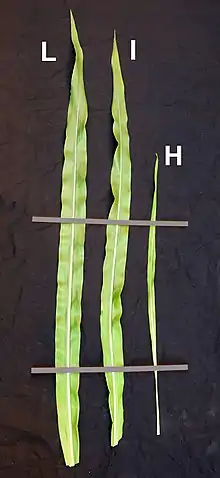Plant density
Plant density is the number of individual plants present per unit of ground area. It is most easily interpreted in the case of monospecific stands, where all plants belong to the same species and have germinated at the same time. However, it could also indicate the number of individual plants found at a given location.
Definition and concepts
Plant density is defined as the number of plants present per unit area of ground. In nature, plant densities can be especially high when seeds present in a seed bank germinate after winter, or in a forest understory after a tree fall opens a gap in the canopy. Due to competition for light, nutrients and water, individual plants will not be able to take up all resources that are required for optimal growth. Especially in the case of light, smaller plants will take up fewer resources than bigger plants, even less than would be expected on the basis of their size differences. This is called 'asymmetric competition' [1] and will cause some subordinate plants to die, in a process that has been named 'self-thinning'.[2] The remaining plants profit as fewer plants will now compete for resources.
Monostands

Many of the processes related to plant density can well be studied in monocultures of even-aged individuals that are sown or planted at the same time. These can be referred to as 'monostands' and are often studied in the context of agricultural, horticultural or silvicultural questions. However, they are also highly relevant in ecology.[3] In general, the total above-ground biomass of a monostand increases with increasing density, up to the point where the biomass saturates. This is what has been dubbed 'constant final yield',[4] and refers to the total plant biomass per unit ground area. Seed production per ground area is not constant, but often declines with density after total biomass per ground area reached its maximum value.[5]
Plant density and self-thinning

Experiments with herbaceous plants have been carried out with extremely high densities (up to 80,000 plants per square meter). At such high densities, these plants will start to compete soon after germination, and eventually a large number of those individuals (up to 95%) will die. In agriculture, farmers avoid these very high densities as they do not contribute to seed yield. Normal densities in modern agriculture depend on final plant size and vary between 5-10 plants per square meter for Maize till 200-300 plants per square meter for Rice or Barley. In forestry, normal densities are less than 0.1 plants per square meter. Not only the biomass per square meter increases with density, but also the Leaf Area Index (LAI, leaf area per ground area). The higher the Leaf Area Index, the higher the fraction of intercepted sunlight will be, but the gain in light interception and photosynthesis will not match the increase in LAI, and this is the reason that total biomass per ground area saturates at high plant densities.
The individual plant in a monostand
Biomass
Contrary to the total biomass per unit ground area, which increases with density until reaching saturation, the average biomass of individual plants in a monostand strongly declines with plant density, such that for every doubling in density individual plants will become ~30-40% smaller.[6] Plants in higher density stands invest relatively more of their biomass in stems (higher Stem Mass Fraction), and less in leaves and roots.
Apart from their weight, plants will change their phenotype in many other ways and at different integration levels.[6]
Leaves

Individual plants in dense stands have fewer leaves and they are often smaller and more narrow (see photo). Leaves of high-density plants are thinner (higher SLA – leaf area per unit mass), especially lower in the vegetation, with a similar concentration of nitrogen per unit mass, but a lower nitrogen content per area.
Stems
Average plant height or vegetation height often remains remarkably similar, but a very consistent difference is that the stems of high-density plants have a much smaller diameter. They also have fewer side shoots (tillers) in the case of grasses, or branches in the case of herbs and trees.
Roots
Rooting depth is probably rather similar, and so is root morphology (SRL – root length per unit mass), but there are fewer roots per plant.
Physiology
In dense stands, there is a strong gradient of light from top to bottom. Lower leaves in high-density stands will therefore have a lower photosynthetic rate and a lower transpiration rate than similar leaves of plants in open stands. There are indications that also the well-illuminated top leaves may have a lower photosynthetic capacity in densely-grown plants.
Seed production
Because densely-grown plants are smaller, they will also produce fewer seeds per individual. But also the seed production as a fraction of total plant biomass (harvest index) is lower, and so is the seed weight of an individual seed.
See also
References
- Weiner, J.; Thomas, S.C. (1986). "Size variability and competition in plant monocultures". Oikos. 47 (2): 211–222. doi:10.2307/3566048. JSTOR 3566048.
- Yoda (1963). "Self-thinning in overcrowded pure stands under cultivated and natural conditions (Intraspecific competition among higher plants". Journal of the Insitute of Polytechnics, Osaka City University. D. 14: 107-129.
- Harper, JL (1977). Population biology of plants. London: Academic Press.
- Weiner, J; Freckleton, RP (2010). "Constant final yield". Annual Review of Ecology, Evolution, and Systematics. 41: 173-192. doi:10.1146/annurev-ecolsys-102209-144642.
- Li, J; et al. (2015). "Variations in Maize dry matter, harvest index, and grain yield with plant density". Agronomy Journal. 107 (3): 829-834. doi:10.2134/agronj14.0522.
- Postma, JA; et al. (2021). "Dividing the pie: A quantitative review on plant density responses". Plant, Cell & Environment. doi:10.1111/pce.13968. PMID 33280135.